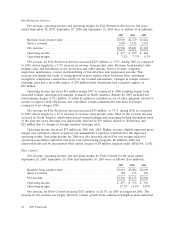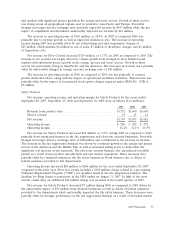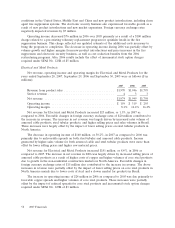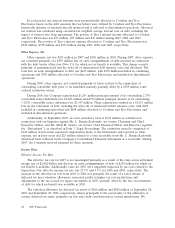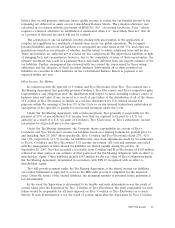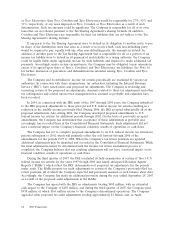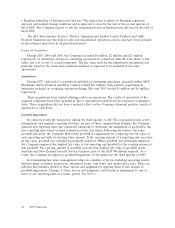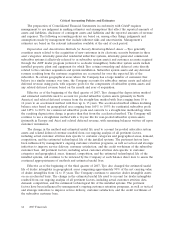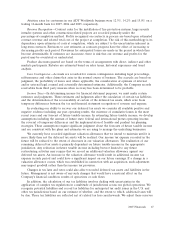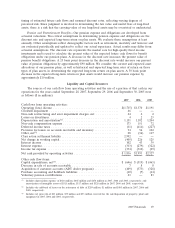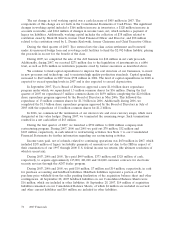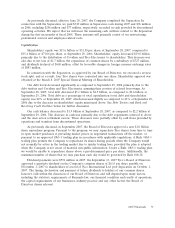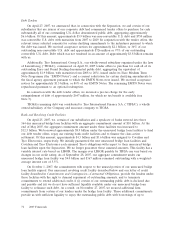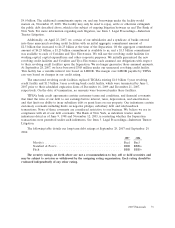ADT 2007 Annual Report Download - page 158
Download and view the complete annual report
Please find page 158 of the 2007 ADT annual report below. You can navigate through the pages in the report by either clicking on the pages listed below, or by using the keyword search tool below to find specific information within the annual report.Critical Accounting Policies and Estimates
The preparation of Consolidated Financial Statements in conformity with GAAP requires
management to use judgment in making estimates and assumptions that affect the reported amounts of
assets and liabilities, disclosure of contingent assets and liabilities and the reported amounts of revenue
and expenses. The following accounting policies are based on, among other things, judgments and
assumptions made by management that include inherent risks and uncertainties. Management’s
estimates are based on the relevant information available at the end of each period.
Depreciation and Amortization Methods for Security Monitoring-Related Assets —Tyco generally
considers assets related to the acquisition of new customers in its electronic security business in three
asset categories: internally generated residential subscriber systems, internally generated commercial
subscriber systems (collectively referred to as subscriber system assets) and customer accounts acquired
through the ADT dealer program (referred to as dealer intangibles). Subscriber system assets include
installed property, plant and equipment for which Tyco retains ownership and deferred costs directly
related to the customer acquisition and system installation. Subscriber system assets and any deferred
revenue resulting from the customer acquisition are accounted for over the expected life of the
subscriber. In certain geographical areas where the Company has a large number of customers that
behave in a similar manner over time, the Company accounts for subscriber system assets and related
deferred revenue using pools, with separate pools for the components of subscriber system assets and
any related deferred revenue based on the month and year of acquisition.
Effective as of the beginning of the third quarter of 2007, Tyco changed the depreciation method
and estimated useful life used to account for pooled subscriber system assets (primarily in North
America) and related deferred revenue from the straight-line method with lives ranging from 10 to
14 years to an accelerated method with lives up to 15 years. The accelerated method utilizes declining
balance rates based on geographical area ranging from 160% to 195% for residential subscriber pools
and 145% to 265% for commercial subscriber pools and converts to a straight-line methodology when
the resulting depreciation charge is greater than that from the accelerated method. The Company will
continue to use a straight-line method with a 14-year life for non-pooled subscriber system assets
(primarily in Europe and Asia) and related deferred revenue, with remaining balances written off upon
customer termination.
The change in the method and estimated useful life used to account for pooled subscriber system
assets and related deferred revenue resulted from our ongoing analysis of all pertinent factors,
including actual customer attrition data specific to customer categories and geographical areas, demand,
competition, and the estimated technological life of the installed systems. The pertinent factors have
been influenced by management’s ongoing customer retention programs, as well as tactical and strategic
initiatives to improve service delivery, customer satisfaction, and the credit worthiness of the subscriber
customer base. All pertinent factors, including actual customer attrition data specific to customer
categories and geographical areas, demand, competition, and the estimated technological life of the
installed systems, will continue to be reviewed by the Company at each balance sheet date to assess the
continued appropriateness of methods and estimated useful lives.
Effective as of the beginning of the third quarter of 2007, Tyco also changed the estimated useful
life of dealer intangibles in geographical areas comprising approximately 90% of the net carrying value
of dealer intangibles from 12 to 15 years. The Company continues to amortize dealer intangible assets
on an accelerated basis. The change in the estimated useful life used to account for dealer intangibles
resulted from our ongoing analysis of all pertinent factors, including actual customer attrition data,
demand, competition, and the estimated technological life of the installed systems. The pertinent
factors have been influenced by management’s ongoing customer retention programs, as well as tactical
and strategic initiatives to improve service delivery, customer satisfaction, and the credit worthiness of
the subscriber customer base.
66 2007 Financials


